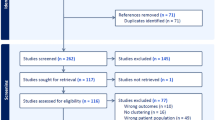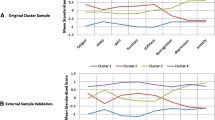Abstract
The heterogeneity of patients meeting American College of Rheumatology (ACR) criteria for a diagnosis of fibromyalgia (FM) challenges our ability to understand the underlying pathogenesis and to optimize treatment of this enigmatic disorder. Our goal was to discern clinically relevant subgroups across multiple psychological and biomedical domains to better characterize the phenomenology of FM. Women meeting 1990 ACR criteria for FM (N = 107) underwent psychological (childhood trauma, mood, anxiety, and stress) and biomedical (neuroendocrine, immune, and metabolic) testing. Cluster analysis identified four distinct subgroups. Subgroups I, II, and III exhibited profiles that included high psychological distress. Subgroup I was further distinguished by a history of childhood maltreatment and hypocortisolism, and these women reported the most pain and disability. Subgroup II evinced more physiological dysregulation and also reported high levels of pain, fatigue, and disability. Subgroup III was characterized by normal biomarkers and reported intermediate pain severity with higher global functioning. Subgroup IV was distinguished by their psychological well-being, reporting less disability and pain. Our findings underscore the heterogeneity of both psychological and physiological features among FM patients presenting with nearly identical tender point counts. This subgroup categorization is compatible with hypothesized pathogenetic mechanisms of early trauma, stress system dysregulation, and pro-inflammatory bias, each prominent in some but not all FM patients. Appreciation of distinct FM subgroup features is invaluable for selecting the most appropriate treatment modalities.


Similar content being viewed by others
References
Wolfe F, Smythe HA, Yunus MB, Bennett RM, Bombardier C, Goldenberg DL, Tugwell P, Campbell SM, Abeles M, Clark P (1990) The American College of Rheumatology 1990 criteria for the classification of fibromyalgia. Report of the Multicenter Criteria Committee [see comment]. Arthritis Rheum 33(2):160–172
Bernatsky S, Dobkin PL, De Civita M, Penrod JR (2005) Co-morbidity and physician use in fibromyalgia. Swiss Med Wkly 135(5–6):76–81
Wolfe F (1997) The relation between tender points and fibromyalgia symptom variables: evidence that fibromyalgia is not a discrete disorder in the clinic. Ann Rheum Dis 56(4):268–271
Van Houdenhove B, Egle U, Luyten P (2005) The role of life stress in fibromyalgia. Curr Rheumatol Rep 7(5):365–370
Vierck CJ Jr (2006) Mechanisms underlying development of spatially distributed chronic pain (fibromyalgia). Pain 124(3):242–263
Geenen R, Jacobs JW, Bijlsma JW (2002) Evaluation and management of endocrine dysfunction in fibromyalgia. Rheum Dis Clin N Am 28(2):389–404
Wolfe F, Clauw DJ, Fitzcharles MA, Goldenberg DL, Katz RS, Mease P, Russell AS, Russell IJ, Winfield JB, Yunus MB (2010) The American College of Rheumatology preliminary diagnostic criteria for fibromyalgia and measurement of symptom severity. Arthritis Care Res (Hoboken) 62(5):600–610. doi:10.1002/acr.20140
Flor H, Turk DC (1989) Psychophysiology of chronic pain: do chronic pain patients exhibit symptom-specific psychophysiological responses? Psychol Bull 105(2):215–259
Spertus IL, Burns J, Glenn B, Lofland K, McCracken L (1999) Gender differences in associations between trauma history and adjustment among chronic pain patients. Pain 82(1):97–102
Hauser W, Thieme K, Turk DC (2010) Guidelines on the management of fibromyalgia syndrome—a systematic review. Eur J Pain 14(1):5–10. doi:10.1016/j.ejpain.2009.01.006
Oral R, Can D, Hanci H, Miral S, Ersahin Y, Tepeli N, Bulguc AG, Tiras B (1998) A multicenter child maltreatment study: twenty-eight cases followed-up on a multidisciplinary basis. Turk J Pediatr 40(4):515–523
Giesecke T, Williams DA, Harris RE, Cupps TR, Tian X, Tian TX, Gracely RH, Clauw DJ (2003) Subgrouping of fibromyalgia patients on the basis of pressure-pain thresholds and psychological factors. Arthritis Rheum 48(10):2916–2922
de Souza JB, Goffaux P, Julien N, Potvin S, Charest J, Marchand S (2009) Fibromyalgia subgroups: profiling distinct subgroups using the Fibromyalgia Impact Questionnaire. A preliminary study. Rheumatol Int 29(5):509–515. doi:10.1007/s00296-008-0722-5
Maes M, Lin A, Bonaccorso S, van Hunsel F, Van Gastel A, Delmeire L, Biondi M, Bosmans E, Kenis G, Scharpe S (1998) Increased 24-hour urinary cortisol excretion in patients with post-traumatic stress disorder and patients with major depression, but not in patients with fibromyalgia. Acta Psychiatr Scand 98(4):328–335
Catley D, Kaell AT, Kirschbaum C, Stone AA (2000) A naturalistic evaluation of cortisol secretion in persons with fibromyalgia and rheumatoid arthritis. Arthritis Care Res 13(1):51–61
Goldberg RT, Pachas WN, Keith D (1999) Relationship between traumatic events in childhood and chronic pain. Disabil Rehabil 21(1):23–30
Weissbecker I, Floyd A, Dedert E, Salmon P, Sephton S (2006) Childhood trauma and diurnal cortisol disruption in fibromyalgia syndrome. Psychoneuroendocrinology 31(3):312–324
Dinser R, Halama T, Hoffmann A (2000) Stringent endocrinological testing reveals subnormal growth hormone secretion in some patients with fibromyalgia syndrome but rarely severe growth hormone deficiency. J Rheumatol 27(10):2482–2488
Dessein PH, Shipton EA, Joffe BI, Hadebe DP, Stanwix AE, Van der Merwe BA (1999) Hyposecretion of adrenal androgens and the relation of serum adrenal steroids, serotonin and insulin-like growth factor-1 to clinical features in women with fibromyalgia. Pain 83(2):313–319
Loevinger BL, Muller D, Alonso C, Coe CL (2007) Metabolic syndrome in women with chronic pain. Metabolism 56(1):87–93. doi:10.1016/j.metabol.2006.09.001
Hernanz W, Valenzuela A, Quijada J, Garcia A, de la Iglesia JL, Gutierrez A, Povedano J, Moreno I, Sanchez B (1994) Lymphocyte subpopulations in patients with primary fibromyalgia. J Rheumatol 21(11):2122–2124
Smart PA, Waylonis GW, Hackshaw KV (1997) Immunologic profile of patients with fibromyalgia. Am J Phys Med Rehabil 76(3):231–234
Alonso C, Loevinger BL, Muller D, Coe CL (2004) Menstrual cycle influences on pain and emotion in women with fibromyalgia. J Psychosom Res 57(5):451–458
Yunus MB, Inanici F, Aldag JC, Mangold RF (2000) Fibromyalgia in men: comparison of clinical features with women. J Rheumatol 27(2):485–490
Bernstein DP, Stein JA, Newcomb MD, Walker E, Pogge D, Ahluvalia T, Stokes J, Handelsman L, Medrano M, Desmond D, Zule W (2003) Development and validation of a brief screening version of the Childhood Trauma Questionnaire. Child Abuse Negl 27(2):169–190
Bernstein DP, Fink L, Handelsman L, Foote J, Lovejoy M, Wenzel K, Sapareto E, Ruggiero J (1994) Initial reliability and validity of a new retrospective measure of child abuse and neglect. Am J Psychiatry 151(8):1132–1136
Scher CD, Stein MB, Asmundson GJ, McCreary DR, Forde DR (2001) The childhood trauma questionnaire in a community sample: psychometric properties and normative data. J Trauma Stress 14(4):843–857
Cohen S, Kamarck T, Mermelstein R (1983) A global measure of perceived stress. J Health Soc Behav 24(4):385–396
Watson D, Clark LA, Weber K, Assenheimer JS, Strauss ME, McCormick RA (1995) Testing a tripartite model: II. Exploring the symptom structure of anxiety and depression in student, adult, and patient samples. J Abnorm Psychol 104(1):15–25
Huskisson EC (1983) Visual analogue scales. In: Melzack R (ed) Pain measurement and assessment. Raven, New York, pp 33–37
Piper BF, Dibble SL, Dodd MJ, Weiss MC, Slaughter RE, Paul SM (1998) The revised Piper Fatigue Scale: psychometric evaluation in women with breast cancer. Oncol Nurs Forum 25(4):677–684
First MB, Spitzer RL, Gibbon M, Miriam JBW, Williams, Janet BW (1998) Structured Clinical Interview for DSM-IV Axis I Disorders—non-patient edition (SCID-I/NP, Version 2.0—8/98 revision). Biometrics Research Department, New York State Psychiatric Institute, New York, p 10032
Bennett R (2005) The Fibromyalgia Impact Questionnaire (FIQ): a review of its development, current version, operating characteristics and uses. Clin Exp Rheumatol 23(5 Suppl 39):S154–S162
Cairns RB, Bergman LR, Kagan J (eds) (1998) Methods and models for studying the individual. Sage Publications, Thousand Oaks
Kotter I, Neuscheler D, Gunaydin I, Wernet D, Klein R (2007) Is there a predisposition for the development of autoimmune diseases in patients with fibromyalgia? Retrospective analysis with long term follow-up. Rheumatol Int 27(11):1031–1039
Meeus M, Nijs J (2007) Central sensitization: a biopsychosocial explanation for chronic widespread pain in patients with fibromyalgia and chronic fatigue syndrome. Clin Rheumatol 26(4):465–473. doi:10.1007/s10067-006-0433-9
Hsu MC, Schubiner H, Lumley MA, Stracks JS, Clauw DJ, Williams DA (2010) Sustained pain reduction through affective self-awareness in fibromyalgia: a randomized controlled trial. J Gen Intern Med 25 (10):1064-1070. doi:10.1007/s11606-010-1418-6
van Koulil S, Effting M, Kraaimaat FW, van Lankveld W, van Helmond T, Cats H, van Riel PL, de Jong AJ, Haverman JF, Evers AW (2007) Cognitive-behavioural therapies and exercise programmes for patients with fibromyalgia: state of the art and future directions. Ann Rheum Dis 66(5):571–581
Zautra AJ, Fasman R, Reich JW, Harakas P, Johnson LM, Olmsted ME, Davis MC (2005) Fibromyalgia: evidence for deficits in positive affect regulation. Psychosom Med 67(1):147–155
Schleicher H, Alonso C, Shirtcliff EA, Muller D, Loevinger BL, Coe CL (2005) In the face of pain: the relationship between psychological well-being and disability in women with fibromyalgia. Psychother Psychosom 74(4):231–239
Staud R, Vierck CJ, Robinson ME, Price DD (2006) Overall fibromyalgia pain is predicted by ratings of local pain and pain-related negative affect—possible role of peripheral tissues. Rheumatol (Oxford) 45(11):1409–1415
Burckhardt CS (2006) Multidisciplinary approaches for management of fibromyalgia. Curr Pharm Des 12(1):59–66
Acknowledgments
This study was supported by a grant from the National Institute of Mental Health (MH61083). Dr. Coe receives partial salary support from the NIA, NIAID, and NICHD (AG20166, AI067518, HD38386). During the conduct of the study, Dr. Loevinger was supported by a National Institute of Health training grant (T32AG00265). Support for Dr. Shirtcliff was provided by a Career Development Award, K01-MH077687. This project benefited from the support and staff of our General Clinical Research Center (currently a CTSA 1UL1RR025011). We thank Holly Schleicher, PhD, for her invaluable assistance in data acquisition. We also express our gratitude to Jeff Jefferson, M.D., and Molly Carnes, M.D., M.S., for their editorial comments on early versions of this paper.
Disclosures
None.
Author information
Authors and Affiliations
Corresponding author
Additional information
This study is from the University of Wisconsin Mind/Body Center, Departments of Psychology, Psychiatry, and Rheumatology.
Rights and permissions
About this article
Cite this article
Loevinger, B.L., Shirtcliff, E.A., Muller, D. et al. Delineating psychological and biomedical profiles in a heterogeneous fibromyalgia population using cluster analysis. Clin Rheumatol 31, 677–685 (2012). https://doi.org/10.1007/s10067-011-1912-1
Received:
Revised:
Accepted:
Published:
Issue Date:
DOI: https://doi.org/10.1007/s10067-011-1912-1




